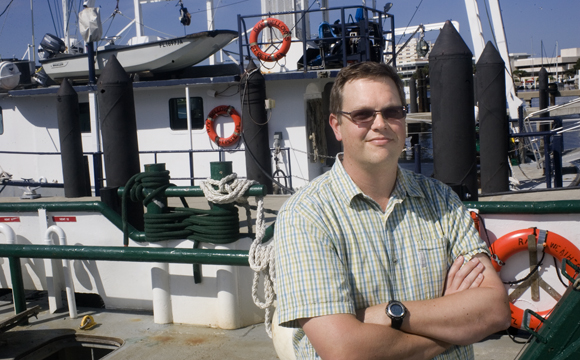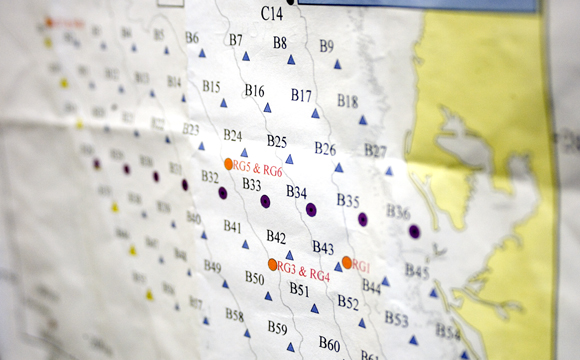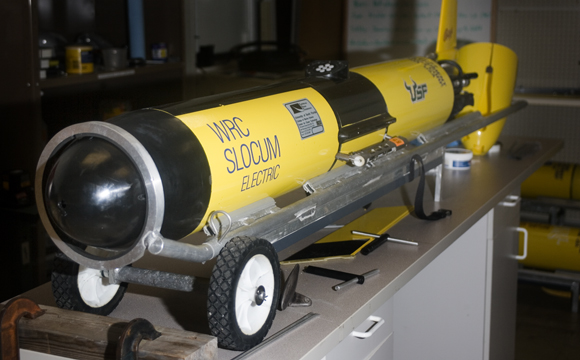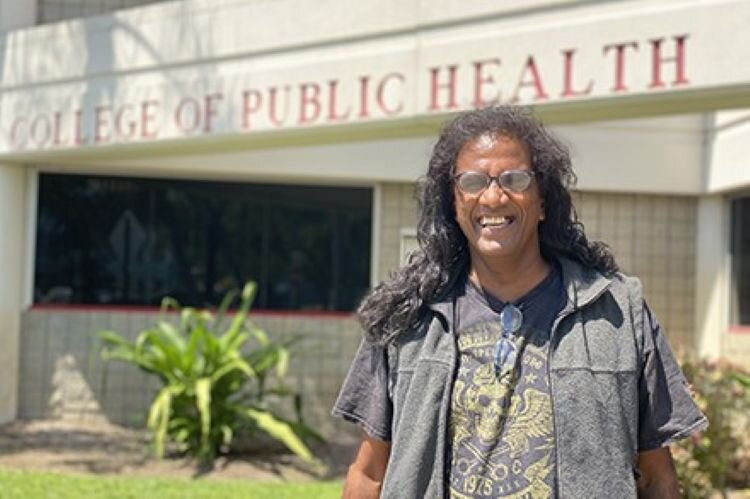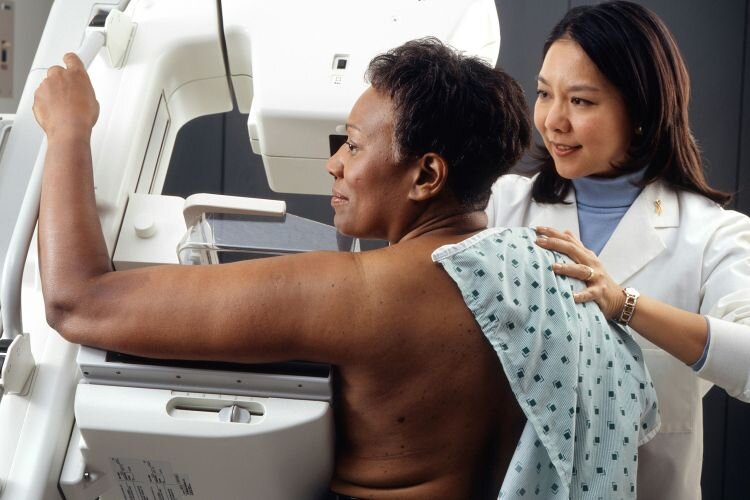Dolphins’ Greatest Hits Rock The Gulf
University of South Florida Associate Professor David Mann listens to the sounds dolphins use to communicate in the Gulf of Mexico. The work began in 2007 thanks to a 3-year, $1.63 million grant from the National Oceanographic Partnership Program. The project got another boost this year with $300,000 in federal economic stimulus money that will allow the work to continue through August 2011.
David Mann and his team are eavesdropping on the Gulf of Mexico.
But don’t tell the dolphins.
Mann, a biological oceanographer at the University of South Florida, and about 20 other scientists have created the largest non-military underwater listening post ever assembled in the United States.
Their submerged microphones, called hydrophones, are recording dolphin sounds beneath a 7,400-square-mile patch of the Gulf off the coast of west-central Florida.
“It’s not ‘The Silent World’ of Jacque Cousteau,” Mann says, referring to the 1956 book and documentary film by the famous French oceanographer. “There are a lot of things out there making noise, a lot of animals using sounds to communicate.”
Mann, 42, and his colleagues are primarily trying to determine the distribution and behavior of spotted and bottlenose dolphins by monitoring their underwater sounds.
The project acronym is DEVO, or Dolphin Ecological Variation and Oceanography. (The name was inspired by the cone-shaped protective
barriers the team uses to keep fishing trawls from scooping up their hydrophones. The red cones resemble the hats worn by the 1970s New Wave band with the hit single, “Whip It.”)
To get the most complete picture of what’s happening beneath the waves, the team also is taking water temperatures, measuring chlorophyll levels and recording other fish sounds and background noises. Scientists from Eckerd College in St. Petersburg, Texas A & M University and Arlington, Va.-based Marine Acoustics Inc. are part of the team.
The work began in 2007 thanks to a 3-year, $1.63 million grant from the National Oceanographic Partnership Program. The project got another boost this year with $300,000 in federal economic stimulus money that will allow the work to continue through August 2011.
Mann says rapid advances in technology have made it easier and cheaper to record underwater audio without a lot of bulky equipment.
Creating A Giant Grid
The digital sound cards he uses are similar to those found in the iPod on your hip.
“We wouldn’t be doing this without consumer electronics,” he says. “This project would not have been possible 10 years ago – no way.”
Placing hydrophones in the Gulf and leaving them there 24/7 also is a lot cheaper than recording sound from aboard research vessels.
“Trying to do the same thing by ship will not give the same depth of information. This compliments the visual work,” says David Wells, a senior conservation scientist with the Chicago Zoological Society who oversees dolphin studies at Mote Marine Laboratory in Sarasota. Wells also is on the PhD review panel for one of Mann’s graduate students.
The massive acoustic array was deployed in June after two years of testing. It includes 100 recorders placed at 63 monitoring stations covering an area slightly larger than seven Hillsborough counties.
The giant grid of hydrophones stretches off the coast from about Tarpon Springs south to around Venice and extends nearly 100 miles westward into the Gulf. The northwest edge of the array is near Steamboat Lumps Reserve, a federal marine protected area.
Each recorder is housed inside a 2-foot length of PVC pipe with the hydrophone sticking out one end – think of a diver’s air tank with an external microphone instead of a hose valve. The recorders are mounted inside PVC cages suspended in the water by floats and mooring blocks.
Recordings are generally taken in stuttered samples of 5 seconds every 4 minutes. Power supplied by 24 D-cell batteries packed inside each recorder is expected to last for a year.
The stuttered recordings add up quickly: 30 minutes of sound per recorder per day, or 50 hours of sound per day for the entire array, with some variations.
“We’re getting so much data we cannot listen to or look at it all,” Mann says.
So the big challenge is developing a software program that’s smart enough and powerful enough to sort though every click, whistle, grunt and other noise picked up by the recorders.
Mann makes this analogy: “It’s like having 100 people give you all the pictures they took on their cameras in a year and telling you to organize it and find some way to make sense of it.”
But like Devo’s hit song says, “When a problem comes along, you must whip it.”
Sorting Out Sounds
A preliminary version of the software is operational but needs improvement, Mann says. The DEVO crew is teaming with high-performance computing system experts to develop powerful clusters of machines to tackle the job.
The project has already discovered a new dolphin sound, which the team calls, “squeekies.” Mann says the low-frequency sounds are related to mating, unlike the high-frequency pitch dolphins use for most communication.
“It’s like Barry White to the dolphins,” Mann says, referring to the late singer known for his bass voice and romantic image. (Barry White. Devo. It’s all about sound!)
Scientists are also concerned about the impact of man-made noise on marine creatures.
“It’s not really known how it affects fish; how it affects dolphins,” Mann says. “Having a good map of noise will help us determine how much of a problem it is.”
Such information could become part of the debate about energy drilling off Florida’s coast.
Wells, of Mote Marine, says the DEVO information will help the National Marine Fisheries Service, which protects dolphins and other marine life and regulates fishing.
There are other hurdles. Mann points to his laptop screen, where a colored sonogram represents the recorded sounds emitting from his computer.
“We hear a lot of things and don’t know what they are,” Mann says. Many fish have muscles that allow them to make sounds that have been recorded. But more species with similar muscles are now getting their first chance to swim up to the microphone.
Even with the project’s unprecedented scale, Mann says that DEVO is just a start, a small window of time compared to studies of red tide or hurricanes that stretch for many years. Good data takes time to develop.
“This will give us a good first look,” Mann says. “Ideally, what we would have is sustained systems that would last for decades.”
Mark Holan is a Tampa-based journalist working from his home in Wellswood, a tree-shaded neighborhood where domesticated peacocks strut along the streets. He swims about five miles a week at the nearby YMCA and volunteers as a docent at the Tampa Bay History Center. Comments? Contact 83 Degrees.

